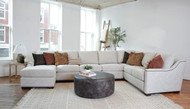The Importance of Scale in Home Design: Achieving Harmony and Balance
13th Aug 2024
In the world of interior design, scale is one of the most crucial yet often overlooked elements that can dramatically impact the look and feel of a space. Understanding and applying the concept of scale correctly is key to creating rooms that are both aesthetically pleasing and functional. Here's why scale matters and how you can use it to your advantage in your home.
What is Scale?
Scale in interior design refers to the size of objects within a space and their relationship to one another and to the overall room. It’s about finding the right balance so that every piece feels like it belongs—nothing too big that it overwhelms, and nothing too small that it gets lost.
For example, in a large living room with high ceilings, a small sofa would feel out of place, creating an unbalanced look. Conversely, a massive sectional in a tiny space can make the room feel cramped and uncomfortable. The goal is to select furniture, decor, and accessories that complement the room's dimensions, creating a cohesive and harmonious environment.
Applying Scale in Your Home
- Furniture Size and Room Scale
Start by considering the size of the room when selecting furniture. Large spaces can handle oversized furniture, like a grand sectional or a large dining table, whereas smaller rooms benefit from more modestly sized pieces that don’t dominate the space. - Focal Points and Proportion
Establishing a focal point, such as a fireplace, a large piece of artwork, or a statement sofa, helps anchor the room. Surround this focal point with complementary elements that don’t compete for attention but rather enhance the overall aesthetic. This approach maintains a sense of proportion and prevents the room from feeling cluttered or disjointed. - Patterns and Textures
The scale also applies to patterns and textures. Large-scale patterns on walls or upholstery can add drama to a room, but it’s essential to balance them with smaller, more subtle patterns to avoid overwhelming the space. For instance, pairing a bold, large-scale wallpaper with smaller, simple patterned cushions can create a dynamic and visually engaging room. - The Role of Negative Space
Don’t forget the importance of negative space—the empty areas around and between objects. Properly managing negative space is vital for achieving a balanced look. It gives the eye a place to rest and prevents the room from feeling too busy or cluttered. - Lighting and Scale
Lighting plays a critical role in how scale is perceived in a room. A large chandelier in a spacious room can add elegance and serve as a focal point, while a smaller, more delicate fixture might be better suited to a compact space. The height of the ceiling should also be considered when choosing lighting fixtures to ensure they complement the room's proportions.
Final Thoughts
Mastering the art of scale is essential for any successful interior design project. By paying close attention to the size and proportion of each element within your space, you can create a balanced, harmonious environment that is both functional and visually appealing. Whether you’re redesigning a single room or an entire home, remember that scale should always be at the forefront of your design considerations.
For more insights on how to effectively use scale and proportion in your interior design projects, check out resources like Minotti London, MyMove, and Bark and Chase (Minotti London) (MYMOVE) (Bark and Chase).

